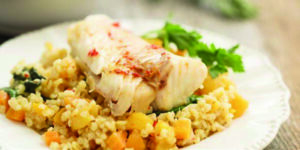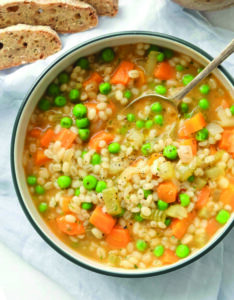 In the realm of grains, rice has long reigned supreme on our plates, be it with ‘dhan-dar-patio, dhansak or pulao-dar’, offering much satisfaction and comfort. However, with changing times, a new challenger approaches… Barley! Let’s delve into a savory discussion on the merits of barley versus rice and discover why barley (or ‘Jav’ in Gujarati), with its ancient allure and modern science, might just be the hero our diets need, especially for those managing diabetes and weight.
In the realm of grains, rice has long reigned supreme on our plates, be it with ‘dhan-dar-patio, dhansak or pulao-dar’, offering much satisfaction and comfort. However, with changing times, a new challenger approaches… Barley! Let’s delve into a savory discussion on the merits of barley versus rice and discover why barley (or ‘Jav’ in Gujarati), with its ancient allure and modern science, might just be the hero our diets need, especially for those managing diabetes and weight.
In the realm of grains, barley stands tall with a robust nutritional profile backed by scientific research. Rich in dietary fiber, particularly beta-glucan, barley offers significant advantages for those navigating diabetes and cholesterol. Beta-glucan slows down the digestion and absorption of carbohydrates, leading to a gradual rise in blood sugar levels after meals. This property helps in stabilizing glucose levels and also improves insulin sensitivity over time – a crucial factor in diabetes care.
Now, rice has been a staple in our bawa meals for generations. Festivities are considered incomplete without Dhan-Dar or Pulav-Dar on happy occasions and Dhansak for the ceremonies of the departed. Delicious, versatile, and comforting, rice has carved a permanent place in our hearts (and our pot-bellies). But it does come with its heavy drawbacks, especially for those watching their waistlines and blood sugar levels.
The Battle Of Benefits: Why Barley Prevails
 Blood Sugar Management: Foods that are low in fiber and high in sugar usually cause a quick spike in your blood glucose (sugar). Your body responds to this sugar spike by releasing insulin, a hormone that brings your blood sugar back down. Over time, this repeated process can lead to diabetes — but barley can help break the cycle.
Blood Sugar Management: Foods that are low in fiber and high in sugar usually cause a quick spike in your blood glucose (sugar). Your body responds to this sugar spike by releasing insulin, a hormone that brings your blood sugar back down. Over time, this repeated process can lead to diabetes — but barley can help break the cycle.
Eating barley helps your gut absorb sugar more slowly, you avoid that fast sugar rush and insulin release. No food can guarantee you’ll never get diabetes, but eating barley is a great way to help lower your risk.
And there’s research to back this up. One study found that people who ate barley had lower glucose and insulin levels after their meal, compared to those who ate rice. Another study showed that post-meal blood glucose was lower in people who consumed beta-glucan compared to those who didn’t. Thus, barley proves to be a healthier choice for diabetics compared to rice.
Weight Control: For those striving to shed extra kilos, barley emerges as a potent ally. Its high fiber content promotes satiety and reduces appetite, potentially curbing overeating and snacking between meals. In contrast, rice, while filling, may not provide the same prolonged feeling of fullness due to its lower fiber content.
Nutrient Density: Beyond its glycemic advantages, barley boasts a treasure trove of essential nutrients. It is a good source of B vitamins, iron, magnesium and selenium – key elements that support overall health, energy production and immune function. In comparison, rice primarily offers carbohydrates with fewer vitamins and minerals per serving.
Fights Cancer: Barley has anti-inflammatory and immune-boosting effects, which could help prevent some types of cancer. It contains vitamin E and polyphenols, which stop oxidation, or cell damage, that lead to tumour growth.
Gut-Friendly And Heart-Friendly: Barley contains prebiotics that feed the gut microbiome to keep you healthy. Beta-glucan also lowers unhealthy (LDL) cholesterol levels, which could prevent plaque buildup in your arteries that leads to heart attacks. Preliminary research also suggests that barley lowers blood pressure – a major factor in heart disease.
Barley Water: An Ancient Elixir
In addition to its culinary uses, barley water has been cherished for centuries across cultures, including our own Parsi community. Known for its cooling properties, barley water has traditionally been used to soothe digestive discomfort, hydrate the body, and even support urinary health. Its mild flavor and gentle nature make it a refreshing beverage option, especially during hot summer days.
Integrating Barley in Parsi Cuisine!
Here’s how you can integrate barley into our cherished Parsi dishes, as this versatile grain adapts beautifully to various cooking methods:
Barley Dhan Dar Patio: Enhance the nutritional value of Dhan Dar by mixing barley (instead of rice) with lentils and aromatic spices. This hearty combination provides a satisfying meal while promoting stable blood sugar levels – a win-win for health-conscious cooks.
Barley Ravo: Indulge your sweet tooth with a guilt-free treat like Barley Ravo. Simmer barley in cashew-coconut-milk with cardamom and a touch of sweetness of dates for a creamy dessert that’s as delightful as it is nutritious.
‘Berry-Barley’ Pulao: Swap out rice for barley in your favorite berry pulao recipe. The nutty flavor and chewy texture of barley adds a delightful twist to this classic dish. Add some caramelized onions, raisins, and toasted nuts for an extra touch of Parsi flair.
Barley Khichdi: For a comforting meal that soothes the soul and stabilizes blood sugar, try barley khichdi. Combine barley with lentils, vegetables, and a dash of turmeric for a wholesome dish that’s as comforting as it is nutritious.
Barley Salad: Looking for a light yet satisfying meal? Whip up a barley salad with fresh vegetables, herbs, and a zesty dressing. This refreshing dish is perfect for summer lunches or as a side dish at your next family gathering.
Dear readers, while rice holds a cherished place in our culinary traditions, barley offers compelling scientific benefits that cannot be overlooked. Whether you’re managing diabetes, aiming for weight loss, or simply seeking to enrich your diet with wholesome nutrients, barley deserves a prominent role in your kitchen.
Let’s raise our glasses – perhaps filled with refreshing barley water – and toast to a future filled with health, happiness, and the vibrant flavors of Parsi cuisine! Cheers!!
- માહ બખ્તર – ચંદ્ર પર પ્રભુત્વ ધરાવતું દિવ્યત્વ - 1 March2025
- હાંસોટમાં 100 વર્ષ જૂનાપારસી પેલેસમાં લૂંટ - 1 March2025
- હૈદરાબાદની ચિનોય અગિયારીએ સાપ્તાહિક હમબંદગીના 19માં વર્ષની ઉજવણી કરી - 1 March2025
